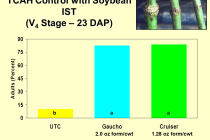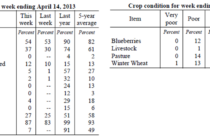👤Tom Allen, Extension Plant Pathologist
🕔19:57, 14.May 2013
Within the past week to 10 days, numerous fields have been diagnosed as having “Pythium seedling disease”. In most cases, herbicide injury has resulted in fields appearing to have an uneven stand as a result of seedling disease. Rarely would a seedling disease be responsible for large acreages of dead seedlings. More than likely, a combination of events have occurred to cause the appearance of seedling disease. Preemergence herbicides, cool temperatures, excessive rainfall following planting immediately prior to emergence, light soil texture, and herbicide injury on stressed soybean seedlings have all compounded the stressful situation.
Read Full Article▸




